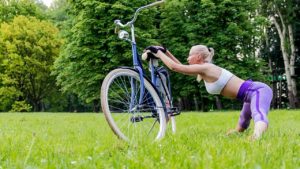Everyone always seems to be worried about stretching out and feeling loose before going on a ride. However, post cycling exercises and stretches are just as equally important.
If it is a tough ride and a person just wants to rest and get some relaxation, it can seem pretty tough to go out there and do proper stretching. However, it might just be exactly what a person needs to get back on track.
Stretching the right parts of the body will be very beneficial for all levels of riders. Cycling can be a full-body experience, so targeting all the different areas and getting the proper stretching at the right time makes the most sense. These are the best post cycling exercises and stretches people need to keep in mind.
1. Neck and Upper Body Trap Stretch
The stretch is fairly simple to do, as it involves sitting down to get the proper amount of rest with their legs. Sitting in an upright position, the goal is to lean the trunk of the body away from the opposite anchored hand to stretch near the top of an arm.
To further the stretch, tilt the head away from the anchored arm to feel like it is going up along the neck.
The stretch helps cyclists who have problems losing similar feeling in their fingers throughout a ride. One of the reasons why this happens is because they are leaning too much on the handlebars or gripping as strong as possible.
This is the best way to loosen up the tightness in the upper arm and neck. Some people might be in the wrong position for too long, and they need to address it as soon as possible.
2. Upward Dog
The stretch begins with a person lying on the floor face down. Make sure to extend the elbows to put the palms of the hands on the floor, resting right around the rib area.
The next step is firmly pressing into the palms to straighten out the arms and lift the torso, hips, and even part of the thighs. The stretch does not need to be held for too long for each repetition, but doing them a few times in sets will be beneficial.
When a person is riding a bike for a long period of time, they are in a hunched back position. It can pull a strain on the lower back, and some muscles do not get the type of work out they need.
This is one of the best ways to go against that cycling position, balancing out the body and getting a stretch in areas that need it significantly.
3. Hip Flexor and Quad Stretch
This is a modified kneeled position for people to get the type of stretch that they need most. The first step is to put one knee on the floor or cushion and the other leg in a forward position that forms a 90-degree knee angle.
The leg with a knee on the ground should bend a bit during the stretch, with the foot up on a rested box behind. The entire setup might be a little difficult at first, but it
is important to be as balanced and in as much control as possible during the stretch. Some people will even push their hips forward a bit so that they feel the stretch a lot. Doing it on both sides will open up the hip flexor and quads.
In order to be successful in cycling, people need to have that power in the right areas. Powerful legs not only need to be strong, but they need to be flexible and mobile. The hip flexors can sometimes be a little tight, so doing the stretch helps quite a bit.
4. Piriformis Stretch
For even more focus on the hip areas, the piriformis stretch is another way to utilize that same box from above. Put one leg onto the box, turned out, and folded so that the shin is parallel to it.
The other leg should be straight back behind for balance. It is also important to keep everything lined up so that the body is stretched the right way.
Try to lean the trunk of the body over the extended leg, and keeping it as straight as possible. The goal is to isolate the piriformis, and get the hip stretched properly.
When riding for a long time, this specific muscle can become pretty tight. By mobilizing it a bit, it can take the pressure off of other parts of the body.
There are not that many people who think about this stretch at first, but it proves to be a favorite one so that the body is a bit more limber.
5. Gastric and Soleus Stretch
There are a lot of cyclists, especially those who are starting out, that tend to put their foot in a position that is not ideal. In particular, they are putting the toe down and having a heel up.
By pushing down this way on the pedals, it is a bit unbalanced. Not only that, but it can cause quite a bit of tightness in the calf area, which could lead to injuries such as plantar fasciitis or even an Achilles issue.
To fight this off, a good stretch post cycling is to start with a stance with one foot slightly in front of the other. The front leg should be bent, while the back leg is straight.
Slide the back foot a few inches forward and start to push the hips back as if sitting in a chair. There should be a stretch in the lower part of the calf, as well as the Achilles. Do it on both sides so that the legs are feeling as good as new.
6. Standard Hamstring Stretches
There is never a bad time to stretch the hamstrings out after any physical activity. Hamstrings are a big part of cycling, and there is nothing worse than having to deal with tight hamstrings if not treated properly.
The simplest way to do a hamstring stretch is to start out in a standard standing position. Rest on one leg, and put the other one forward to start.
Lean into the stretch with the forward leg, keeping the hands in the hip area. Try to go as deep as possible, hold it for a while, and switch legs.
It might seem simple enough, but way too many people overlook the need to do a proper hamstring stretch. Hamstrings are something that can be a lingering problem for quite a while, so do not underestimate the need for this stretch.
7. Camel Pole Stretches
Borrowed from the camel pose yoga stretch, this is a great way to open up the groin, thighs, and entire back. People feel like they get a great stretch out of this pose overall, and it caters specifically to cyclists who might feel like they are in a cramped position for such a long time.
To get started, a person needs to sit in a kneeling position. Rise off the heels, and bring the thighs and torso upright as much as possible.
It might be a bit of a challenge at first, but a person to try to put their hands towards their heels. Extend the stretch as much as possible, hold it for a few seconds, and then do it again.
It might not be the easiest stretch to pull off, but it can help significantly for those who might feel a little tight overall.
Common Questions in Regards to Stretching After a Bicycle Ride

Never put in the proper time and energy when it comes to stretching after a ride? There is no better time to start them now. This is a look at some common questions people have when they are just starting out with stretching.
When Is the Ideal Time to Stretch in Regards to Cycling?
Stretching out in some capacity before and after a ride could prove to be beneficial. What a lot of people do not realize is that stretching out right before a ride might not be the best, because the muscles are fairly cold, If they are not properly warmed up, they could be susceptible to injury if people are trying to do too much.
There is also such a thing as static stretching reducing the. power a person has in their body for any exercise right after the fact.
From a before the ride standpoint, try to do something dynamic to warm up the muscles while stretching at the same time. Otherwise, it could end up being more counterproductive than anything.
This is the more important time to get everything in as much as possible for post cycling needs. This is when static stretching can help, as it restores the muscles and adds length as well, helping a person recover quickly and stay as healthy and limber as possible when they are riding in the future.
Try to do it fairly shortly after riding, as the muscles are still going to be warm enough and ready to take such focus on stretching out.
How Long Should a Person Hold a Stretch?

For the most part, people should hold a stretch for at least 10 or 15 seconds. A lot of people will try to offer something even longer, such as 20 or 30 seconds.
It really just depends on how much the stretch feels as far as a true workout is concerned. Do not cross the line of holding it too long, as it might be harmful.
The worst thing a person can do is hold a stretch for too long, and it becomes actually painful to do that. No one should put themselves in a situation, as it can set them back quite a bit.
The goal of stretching is to avoid soreness, not add to soreness by pushing it too much. They can also do damage if the body is stretched abnormally.
How Often Should Stretching Occur?
After every single ride, a person should do post-ride stretching. This is because the body is already warmed up significantly, and a lot of different muscles are used. Stretching at the end will ensure that the body can recover at a faster rate.
If a person only rides once a week, try to stretch at least a couple of other times during the week. In general, even people who are not relatively active should be trying to stretch at least three times a week.
This is to make sure the body stays pretty limber overall, and people do not lose their flexibility when they are taking some time off riding.
Do Other Body Parts Besides Legs Actually Matter?
Legs do most of the work when cycling, but it would be a very bad idea for people to overlook all the other aspects that go into peddling a bike around.
In fact, stretching out the entire body after going on a long cycling ride will be something that makes the most sense overall.
In particular, other parts besides the legs that need specific attention include the chest and back. Remember that for the majority of the ride, a person is sitting in a relatively awkward position where they might be putting stress on the body without even knowing.
It does not take much for a person to feel like their body is a bit overwhelmed, and that can hold a person back physically.
Besides Stretching, What Else Should a Person Focus On Right After Cycling?
There can never be such a thing as getting too much water or even food in the body to replenish overall. Most people bring water with them when they are riding, but they usually do not get enough.
Drinking a lot of liquids right after the ride is a great way to replenish the body and make sure that there is no cramping that goes on.
Eating something also helps considerably, because most people do not like to eat when they are actually riding. Even if it is just something relatively small, it is better than just going without any food whatsoever.
Some people have to eat something very specific so that they can keep it down, but a person is potentially losing thousands and thousands of calories when they are on their bike. The body can start to feel very weak if there is no food in the system whatsoever.
A Final Look at the Overall Importance of Stretching Out After a Ride
The only way for cyclists to stay on the road as healthy as possible is to make sure they are always stretching out. There are a lot of people out there who feel like they do not get the stretching they need when they need it most.
Maybe they are in bad habits, or they are not doing the right stretching routine to get everything the way they should.
It is very easy to sit down and relax after a long ride, but it can be detrimental to a person trying to improve. Stretching out is the perfect way to really start to build up certain muscles and make them feel stronger overall when riding.
A person is already very well warmed up, and they are going to respond well to stretching.

